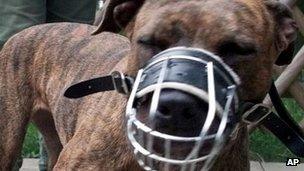Dangerous dog owners face tougher sentences
- Published

The number of people sentenced for dangerous dog offences has risen in recent years
Owners of dangerous dogs in England and Wales now face tougher sentences under new Sentencing Council guidelines.
The new advice for judges and magistrates aims to encourage the courts to use harsher sentences when dealing with offenders.
The body says more offenders will face jail sentences, more will get community orders and fewer will get discharges.
Official figures show that there has been a rise in the number of people sentenced for dangerous dog offences.
In December 2011, the council proposed in a consultation that judges should consider a community order as the starting point for sentencing people who allow a dangerous dog to injure someone.
But under new guidelines announced in May and which have now come into force, the offence will now have a starting point of six months in jail - and, where appropriate, judges should consider up to 18 months.
The top of the sentencing range for possession of a prohibited dog has been set at six months custody.
Where someone deliberately sets a dog on another person intending to injure them, the offender is likely to be charged with assault, the council said.
The council said the new ranges marked an increase in sentencing levels from current practice.
Trevor Cooper, legal consultant for the Dogs Trust, said: "These new guidelines will encourage courts to focus on the key factors of culpability of the owner and the amount of harm to the victim.
"This tougher approach should serve as a stiff reminder to dog owners to keep their pets under proper control and to behave responsibly."
The Sentencing Council issues guidelines to help courts across England and Wales to punish offences more consistently, within the ranges set out by Parliament.
The guidelines also help courts make the best use of their powers so that irresponsible owners who put the public at risk can be banned from keeping dogs, genuinely dangerous dogs can be put down and compensation can be paid to victims.
Offenders jailed
The council has broadened the definition of vulnerable victims so that it applies not only to children but to others such the elderly, disabled and blind or visually impaired people.
The guidelines have also been extended to include injuries to other animals as an aggravating factor in the offence of allowing a dog to be out of control and causing injury.
Anne Arnold, district judge and member of the Sentencing Council, said: "Most dog owners are responsible and take good care of their pets, but we've seen more and more cases coming before the courts of owners who have put the public at risk or let their dog cause injuries - sometimes very serious - to people.
"As a result, this new sentencing guideline encourages courts to use their full powers when dealing with offenders so that they are jailed where appropriate."
Peter Chapman, Chairman of the Magistrates' Association Sentencing Committee said: "For the first time magistrates will have all they need in one document to help them sentence the offender, disqualify him from future dog ownership if appropriate, order compensation to the victim and order destruction of the dog if necessary."
- Published22 May 2012
- Published15 May 2012
- Published25 January 2012